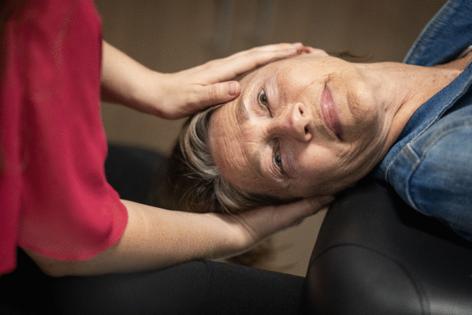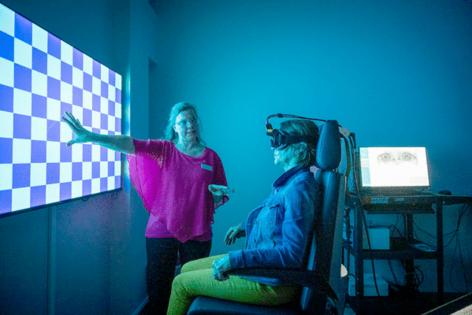Dizzying problem: Minnesota clinics treating more vertigo, imbalance
Published in Health & Fitness
MINNEAPOLIS -- An aging population, still recovering from the COVID-19 pandemic, is seeking more treatment for dizziness and imbalance in Minnesota.
Clinics specializing in the diagnosis and treatment of dizziness have opened or expanded across the Twin Cities, and their appointments are filling up. Associated Hearing Care hired a specialist and installed a rotating diagnostic chair last year at its St. Paul clinic, and already dizziness evaluations make up 10% of the provider’s business across 10 clinics.
“By the time they get to us they’ve been dizzy for a long time, or they’ll have episodes where they’re dizzy and then it gets better and then they get dizzy again,” said Rebecca Younk, the clinic group’s owner and chief audiologist. “For some people, it can be debilitating because, if you’re going to get dizzy all of a sudden out of nowhere, you get fearful.”
Dizziness is hardly a new medical phenomenon, ranking in one study as the third-most-common complaint by patients. The condition covers a range of symptoms, from feeling lightheaded or unsteady to the spinning sensation known as vertigo.
It can stem from a drug interaction, heart problems or chronic diseases such as diabetes. But clinicians said there has been an increase in patients seeking care primarily for dizziness, which often results from dysfunction in the inner ear — where three fluid-filled loops make up the vestibular system that coordinates with the brain and head movements to achieve balance.
Vestibular problems increase with age, which makes an increase likely for an aging state like Minnesota, where almost 1 in 5 residents is a senior citizen. But physical therapist Kristine Feriancek said there is a COVID-19 connection, too.
Some patients have dizziness related to post-COVID health problems. Others are finding dizziness intolerable as they belatedly return to pre-COVID exercise and activity routines, she said.
“I’ve met a number of people that are just, ‘You know, I just never got back into being active. I lost that part of my routine,’” said Feriancek, who practices at a HealthPartners-affiliated physical therapy clinic in Maple Grove. “Habits are hard to build.”
Rising rates of diabetes, hypertension and other chronic diseases also could be causing significant dizziness, though proof of an actual increase is challenging.
HealthPartners, at the Minnesota Star Tribune’s request, reviewed the number of patient visits that resulted in three common billing codes related to dizziness. The list included clinic visits for benign paroxysmal positional vertigo (BPPV), which occurs when calcium crystals in the ear canal that regulate balance leak out and send false signals to the brain.
The health system averaged less than 3,000 visits per month a decade ago, but that number gradually increased and surged to a record 6,440 in May. HealthPartners as a system grew substantially over the past decade, though, so an increase in patients of all conditions would be expected.
Feriancek said it’s possible the prevalence of dizziness hasn’t increased, but that people have grown less tolerant of it and are more likely to seek medical care than their parents. If true, she views that as a good trend.
“People just think dizziness is a normal part of aging and you kind of have to accept that,” she said. “We don’t want that to be the case.”
Providers have anticipated rising demand. Ridgeview Health opened a balance center in Waconia in 2009 while the National Dizzy and Balance Center expanded a decade ago to four locations across the Twin Cities. The Minnesota Therapy and Balance Center opened its first clinic in Plymouth in 2022. Allina Health added vestibular services to its Eden Prairie clinic as part of an expansion this year.
One goal is preventing falls, which studies have estimated are two to 12 times more likely among people with vestibular disorders. Wisconsin and Minnesota have the highest rates of fall-related deaths among states. Minnesota last year recorded more than 1,600 such deaths, a 33% increase in five years.
Exams at Associated Hearing helped Steven Guthrie of Cottage Grove identify some inner-ear problems that were contributing to dizziness and putting him at risk for falls. A combination of two medications was causing lightheadedness as well, but the 74-year-old said he needs both of them.
Guthrie said he addressed some tooth decay that was causing swelling and worsening his ear problems, but mostly the exams convinced him to compensate for his dizziness. He wears an Apple watch that registers falls and calls for emergency help, and uses a type of walker called a rollator when doing exercise walks with his wife at the Mall of America.
“Otherwise, I’m going to be all over the place,” he said.
Patients might be seeking more care for dizziness because clinicians have more to offer. The diagnostic chair at Associated Hearing analyzes eye movements and how the vestibular system responds when patients are spun around in circles.
Treatment options have increased as well. The most common solution for BPPV is a series of head and body movements called the Epley maneuver that moves crystals back into proper position in the ear canal so they can regulate balance.
More recently, a so-called somersault maneuver was developed that can be easier for seniors and people with limited mobility to reduce their dizziness, Feriancek said.
“They may not be climbing ladders, but they may need to get back to their exercise class,” she said, “or just moving around the house.”
©2025 The Minnesota Star Tribune. Visit startribune.com. Distributed by Tribune Content Agency, LLC ©2025 The Minnesota Star Tribune. Visit at startribune.com. Distributed by Tribune Content Agency, LLC.















Comments